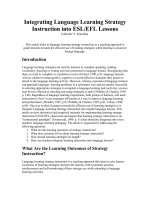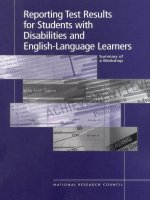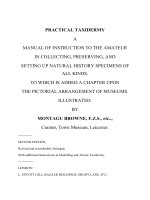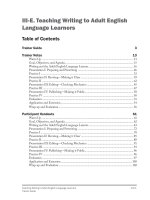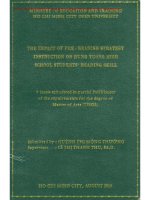Reading strategy instruction to Vietnamese young language learners: Teachers’ prac-tices and perceptions
Bạn đang xem bản rút gọn của tài liệu. Xem và tải ngay bản đầy đủ của tài liệu tại đây (232.54 KB, 10 trang )
<span class='text_page_counter'>(1)</span><div class='page_container' data-page=1>
<i>DOI: 10.22144/ctu.jen.2017.059 </i>
<b>Reading strategy instruction to Vietnamese young language learners: Teachers’ </b>
<b>practices and perceptions </b>
Tran Thi Be Ba and Nguyen Buu Huan
<i>Center for Foreign Languages, Can Tho University, Vietnam </i>
<b>Article info. </b> <b> ABSTRACT </b>
<i>Received 22 Oct 2016 </i>
<i>Revised 05 Feb 2017 </i>
<i>Accepted 31 Oct 2017</i>
<i><b> There has been a growing interest in involving teaching English to young </b></i>
<i>learners in Vietnam in recent years. However, teaching English </i>
<i>commu-nication skills, especially reading for children, is not an easy job although </i>
<i>reading is widely known as one of the most important skills in language </i>
<i>learning and teaching. To overcome this difficulty, teachers are likely to </i>
<i>implement various reaching strategies that help motivate students to read </i>
<i>and involve them in the lessons. This paper examines the reading </i>
<i>strate-gies that English as Foreign Language (EFL) teachers reported using in </i>
<i>young language learners’ classes and explores their perceptions of </i>
<i>read-ing strategy types that can attract students’ interests. The data discussed </i>
<i>in this paper were collected through questionnaires and interviews. The </i>
<i>findings indicate that of 11 reading strategies, using context clues was the </i>
<i>most frequently used and that four most favorite reading strategies that </i>
<i>enhance students’ interests in reading include games, pair work, group </i>
<i>work, and role play. </i>
<i><b>Keywords </b></i>
<i>Reading strategies, students’ </i>
<i>interests, teachers’ </i>
<i>percep-tions, young learners </i>
Cited as: Ba, T.T.B. and Huan, N.B., 2017. Reading strategy instruction to Vietnamese young language learners:
<i>Teachers’ prac-tices and perceptions. Can Tho University Journal of Science. 7: 138-147. </i>
<b>1 INTRODUCTION </b>
Reading, one of the most important skills in
for-eign language teaching and learning, is a process of
making sense of a particular text to obtain
knowledge of a field by individuals. It is, therefore,
an interactive activity of decoding and
understand-ing the meanunderstand-ing-makunderstand-ing process between the
read-er and the text (Goodman, 1965, 1967; Andread-erson,
2003; Alyousef, 2006; Linse and Nunan, 2006;
Israel and Duffy, 2009; Shin and Crandall, 2014).
Reading is also crucial for learners of English as a
second or foreign language to ensure success in
language learning and in other areas of learning
(Lefevre, 1964; Anderson, 2003; Zhang, 2010). In
order to align with the increased recognition of the
need for processing information written in English,
more and more foreign language centers have been
founded and numerous learning materials in
Eng-lish become available online. This trend benefits
children in the way that they are likely to have
more opportunities to approach foreign language
learning in addition to their mother tongue than
their parents did before. Moreover, several studies
highlight the vital role of reading in children’s
de-velopment and their foreign language learning
(e.g., Shin and Crandall, 2014). However, teaching
young learners to read at an early age is a
challeng-ing task, so it requires a great deal of teachers’
<i>en-deavour (Blair et al., 2007). </i>
</div>
<span class='text_page_counter'>(2)</span><div class='page_container' data-page=2>
study reported in this article mainly focuses on
teaching English reading strategies to young
learn-ers as reading instructions have been unnoticed.
In particular, this paper presents the reading
strate-gies English as Foreign Language (EFL) teachers
reported using in their reading classes for young
language learners and their perceptions of students’
preferred reading strategies in the learning process.
This paper is aimed to answer the research
ques-tions:
What are the reading strategies teachers
reported using in young language learners classes?
How do teachers perceive students’ interests
towards the use of reading strategies?
<b>2 LITERATURE REVIEW </b>
The following section reviews the literature of
three concepts that are crucial to motivating
learn-ers to study reading: young language learnlearn-ers,
reading, and reading teaching strategies.
<b>2.1 Young Language Learners </b>
<i>The term young language learners (YLLs) is </i>
broadly used to indicate the children within the age
span. Various researchers have different
perspec-tives of this concept. Scott and Ytreberg (1990)
assume young learners as children between the
ages of five and ten or 11 while Phillips (1993) and
Kalendova (2008) define young learners as
chil-dren from five or six to 11 or 12 years old. Another
view is that children who have not yet started to
read at the age of three to six are considered as
very young learners (Reilly and Ward, 1997).
McKay (2006), and Shin and Crandall (2014) share
similar ideas that YLLs are students between the
ages of approximately five and 12 who are learning
a foreign or second language. Přibilová (2008)
con-tends that the term ‘young learners’ is applied for
learners between the age ranges from three to 18.
<i>In this paper, the authors use the term young </i>
<i>learn-ers as children whose age range is from five to 12 </i>
years old.
<b>2.2 Characteristics of young learners </b>
Since young learners are referred to children from
different ages between five and 12 years old; it is,
therefore, important to consider some common
characteristics of this type of learners. YLLs are
believed to be able to learn or acquire a second or
foreign language easily. Their learning and
acquisi-tion at this age are often incidental. On the other
hand, children from seven to 12 years old can
be-come aware of how they are learning (Scott and
Ytreberg, 1990; Slattery, 2013). At this age,
chil-dren develop better eye-hand co-ordination, their
pictures become more recognizable and detailed,
they can do simple craft activities such as cutting,
sticking and folding. Moreover, they learn how to
sort, classify, match things or recognize the “odd
one out.” They are able to follow a story, predict
what might come next, and ask question about it.
Additionally, they can act as a character in the
reading text. Naturally, there are children who do
not really want to say anything until they are asked
or willing to speak out what they think or
under-stand (Reilly and Ward, 1997). Children are
ener-getic and physically active. Therefore, it is
im-portant for teachers to take advantage of dynamic
energy of young learners to create effective
learn-ing (McKay, 2006; Shin and Crandall, 2014).
Moreover, young children are less inhibited.
Spe-cifically, they are not worried about using the
lan-guage even though their proficiency is limited, and
they are not afraid of participating in activities
without feeling embarrassed (Reilly and Ward,
1997; Shin and Crandall, 2014). Students at this
age group normally have short attention span (as
little as 10 to 15 minutes) and are easily distracted
by other pupils (Reilly and Ward, 1997; McKay,
2006; Shin and Crandall, 2014). Young learners
like to communicate with others, and they are also
interested in working and playing games with each
other (Scott and Ytreberg, 1990; McKay, 2006;
Shin and Crandall, 2014). Nevertheless, some
chil-dren who are still self-centered may well enjoy
<b>playing alone or may not cooperate with others. </b>
<b>2.3 Reading </b>
</div>
<span class='text_page_counter'>(3)</span><div class='page_container' data-page=3>
and a text in which learners are involved in
pro-cessing, constructing texts, and elaborating its
meaning to enhance comprehension (Paris and
Hamilton, 2009; Carrell and Grabe, 2013). Drawn
on these perspectives, in this study, reading is
de-fined as an interactive process between the reader,
a given text, and the context in which the reader
decodes information and understand the meaning
of such triad.
<b>2.4 Reading Strategies </b>
According to Macmillan English Dictionary for
Advanced Learners, a strategy is considered as a
plan or a method or a skill for achieving something
for a long period to some extent. Færch and Kasper
(1983) claim that reading strategies reveal how
learners interact with the text and how it influences
their comprehension. Garner (1987) defines
read-ing strategies as what learners act to construct
meaning. Reading strategies can help learners with
the acquisition, storage and retrieval of
infor-mation. Moreover, when readers face some
com-prehension problems, they can use strategies to get
rid of them. To put it differently, reading strategy is
defined as a plan for solving problems encountered
in constructing meaning (Richards and Renandya,
2002). Additionally, reading strategy can be
viewed as the way in which readers interact with
the written texts and enhance text comprehension
(Rajoo and Selvaraj, 2010). As for teachers of
Eng-lish, reading strategies are utilized to help students
become active readers who are able to be
responsi-ble for their own reading comprehension (Adler,
2004). In this paper, reading strategies are
concep-tualized as processes that teachers show learners
how to approach a particular text and make sense
<b>of what they are going to read for comprehension. </b>
Numerous studies have been conducted to present
results supporting reading teaching strategies. For
example, Klingner and Vaughn (1999) claim that
the combination between reading comprehension
strategy instruction and cooperative learning could
promote reading comprehension, content learning
and acquisition. Also, Adler (2004) holds a view
that there are seven strategies that teachers can use
to teach learners reading comprehension. They
include monitoring, metacognition, graphic and
semantic organizers, answering questions,
generat-ing questions, recognizgenerat-ing story structure, and
summarizing information. Killen (2013) mentions
nine strategies as effective for teachers: direct
in-struction, discussion, small-group work,
coopera-tive learning; problem solving, inquiry, case study,
role-play, and writing. Moreover, research on
suc-cessful reading strategies in teaching middle-grade
learners proposes three reading categories to
con-sider when planning lessons (Bolos, 2012),
includ-ing interactive read-aloud, comprehension
strate-gies, and vocabulary enrichment.
In Shin and Crandall’s (2014) work, they suggest
11 reading strategies. These include predicting,
monitoring, confirming, connecting, questioning,
skimming, scanning, distinguishing, using context
clues, paraphrasing or summarizing, and visualizing.
Although these investigations have provided
litera-ture for reading teaching strategies which can be
used in teaching English reading for younger and
older learners, the results are not applicable in
Vi-etnamese teaching context.
While some researchers (Song, 1998; Sheorey and
Mokhtari, 2001; Duke and Pearson, 2002; Salataci
and Akyel, 2002; Piller and Skillings, 2005; Duke
<i>et al., 2011; Bolos, 2012; Semtin and Maniam, </i>
2015) have conducted various studies in reading
strategies, the existing literature does not
particu-larly take into account teaching strategies to young
learners within the teaching and learning context of
English in Vietnam. Therefore, the study reported
in this paper draws upon Killen’s (2013) and Shin
and Crandall’s (2014) reading strategies to
exam-ine whether these strategies listed below are
appro-priate in teaching reading to young learners in
Vi-etnam and which strategies teachers perceived that
students are most interested in. Fifteen strategies
were mentioned in this study: direct instruction,
discussion, small-group work, role-play, writing,
monitoring, confirming, connecting, questioning,
skimming, scanning, distinguishing, using context
clues, visualizing, and prediction.
<b>3 THE STUDY </b>
This study is aimed to explore reading strategies
teachers reported using in their young learners’
classes as well as their perceptions on strategies
students were most interested in. This study was a
descriptive study that establishes the naturalness of
the phenomenon to gain a complete picture of the
study under investigation (Creswell, 2014). The
quantitative data using questionnaires were used to
examine reading strategies used by teachers. To
deepen understanding of the teachers’ perceptions
of students’ preferred reading strategies, interview
data were conducted.
</div>
<span class='text_page_counter'>(4)</span><div class='page_container' data-page=4>
the qualitative data, and hence, the data analysis is
internally consistent and coherent (Malhotra, 2006;
Wilkinson and Birmingham, 2003; Creswell,
2012). As a result, in this present study, the
qualita-tive data were collected from questionnaires
deliv-ered to 63 EFL teachers. Each questionnaire
in-cludes two sections with the introduction of the
aims of the study at the beginning. The first section
consisted of background information of
partici-pants/ teachers (age, gender, place of work and
year(s) of teaching experience). The major part of
the questionnaire included 39 items in which there
were statements of reading strategies teachers used.
Diefenbach and his colleagues (1993, cited in
Cummins and Gullone, 2000) state that a
seven-point scale is likely to provide more choices than a
five-point scale. Therefore, these items were
cate-gorized into 15 clusters of teaching reading
strate-gies. The questionnaires were designed using a
seven-point Likert-scale ranging from 1 (never) to
7 (always) to examine the reading strategies that
the teachers in the present study used in their YLL
classes.
McNamara (1999) indicates that interviews are
particularly useful for understanding the story
be-hind a participant’s experiences as well as pursuing
in-depth information around the topic. Wilkinson
and Birmingham (2003) also state that interview is
used as a way to obtain detailed information of a
subject or topic. These interviews may have some
questions to gather basic factual data on
partici-pants such as age and gender, but usually they
fo-cus more on the participant's thoughts, feelings,
experiences, knowledge, skills, ideas and
prefer-ences (Turner, 2010). Therefore, an open-ended
interview was conducted to gain in-depth
under-standing of the reading strategies teachers reported
using in their YLLs’ classes. Additionally, the
in-terview data were utilized to explore teachers’
per-ceptions of the strategies that students were most
interested in. Five teachers who worked in foreign
language centers, schools, and university
partici-pated in the interviews.
<b>4 FINDINGS </b>
<b>4.1 Quantitative Analysis </b>
To investigate the reading strategies reported using
by EFL teachers in their young learners’ class, a
questionnaire was utilized. The data collected from
the questionnaire were subjected to SPSS version
16.0 and proved to be reliable (α= .69). The
de-scriptive statistics was run on the mean score of the
frequency use of reading strategies, and the result
was shown in Table 1.
<b>Table 1: Frequency of reading strategies used </b>
<b>N Minimum Maximum Mean SD </b>
MEAN 63 3.00 5.74 4.70 .54
The one-sample t-test was run on the frequency of
reading strategies reported by EFL teachers in
in-structing English to YLLs and the test value 4.0.
The result shows that there was a significant
differ-ence between the mean score of teachers’ reported
use of reading strategies in instructing English to
<i>young language learners (M=4.70) and the test </i>
<i>val-ue 4.0, the accepted mean for average (t= 10.13; </i>
<i>p=.00). The frequency of the reading strategies </i>
reported using by teachers in instructing English to
young language learners was high.
In order to identify types of reading strategies
teachers reported using, the descriptive statistics
was run on the mean score of the 15 clusters in the
questionnaire. The result was briefly illustrated in
Table 2.
<b>Table 2: Frequency of reading strategies reported to use </b>
<b>N </b> <b>Minimum </b> <b>Maximum </b> <b>Mean </b> <b>SD </b>
Using Context Clues 63 3.00 7.00 5.51 0.85
Connecting 63 2.00 7.00 5.37 1.06
Questioning 63 2.67 6.67 5.25 0.88
Prediction 63 1.00 7.00 5.13 1.32
Skimming 63 1.00 7.00 5.10 1.20
Distinguishing 63 3.00 7.00 5.06 0.94
Direct Instruction 63 3.00 6.67 4.84 0.75
Visualizing 63 1.67 7.00 4.76 1.23
Confirming 63 2.33 6.33 4.60 0.94
Discussion 63 1.00 7.00 4.47 1.22
Small Group Work 63 2.00 6.67 4.46 0.96
Role-Play 63 1.00 7.00 4.26 1.23
Writing 63 1.00 6.33 4.13 1.13
Monitoring 63 2.00 6.33 4.09 0.81
</div>
<span class='text_page_counter'>(5)</span><div class='page_container' data-page=5>
As can be seen from Table 2, the mean score of
frequency of reading strategies teachers reported
using in terms of variables ranged from 3.59 to
5.51 with high standard deviations from 0.75 to
1.32 among participants’ responses to variables.
<i>The one-sample t-test was run on the mean scores </i>
of the frequency use of reading strategies of each
variable and the test value was 4, the average scale.
The results show that the reading strategies use
reported by teachers was distributed in three
differ-ent scales in frequency.
For the variables of using context clues,
connect-ing, questionconnect-ing, prediction, skimmconnect-ing,
distin-guishing, direct instruction, visualizing,
confirm-ing, discussion and small group work, the result
showed that the mean scores of frequency of
read-ing strategies reported usread-ing were different from
the test value 4 (Table 3). The frequency of those
reading strategies reported using was high.
<b>Table 3: Means of reading strategies in high level of frequency </b>
<b>t </b> <b>df </b> <b>Sig. (2-tailed) </b> <b>Mean </b> <b>SD </b>
Using context clues 14.05 62 .00 5.51 0.85
Connecting 10.20 62 .00 5.37 1.06
Questioning 11.38 62 .00 5.25 0.88
Prediction 6.77 62 .00 5.13 1.32
Skimming 7.33 62 .00 5.10 1.20
Distinguishing 9.02 62 .00 5.06 0.94
Direct instruction 8.91 62 .00 4.84 0.75
Visualizing 4.87 62 .00 4.76 1.23
Confirming 5.08 62 .00 4.60 0.94
Discussion 3.04 62 .00 4.47 1.22
Small group work 3.78 62 .00 4.46 0.96
With regard to role-play, writing, monitoring, the
<i>results indicated that the mean scores of frequency </i>
<i>of reading strategies reported using (Mr= 4.26, SD= </i>
<i>1.23, Mw= 4.13, SD= 1.13, Mm= 4.09, SD= 081) </i>
<i>were not different from the test value 4 (t= 1.67, </i>
<i>df= 62, p= 0.10; t= .93, df= 62, p= 0.35; t= .89, df= </i>
<i>62, p= 0.37). The frequency of using role-play, </i>
writing and monitoring in instructing English to
YLLs were moderate.
Regarding scanning, the result indicates that the
mean score of frequency of reading strategies
<i>teachers reported using (M= 3.59, SD= 1.12) was </i>
<i>different from the text value 4 (t=-2.92, df= 62, </i>
<i>p=.00). The frequency of using scanning in </i>
in-structing English to YLLs was low.
An analysis from the questionnaire reveals that 11
reading strategies were most frequently used in
teaching young learners. In order to investigate the
most frequently-used strategy among those, the
one-sample t-test was run on the mean score of the
frequency use of reading strategies of each variable
in this group and the test value was 5.51 (the mean
score of using context clues reading strategy as
well as the highest mean score of the group). The
results show that there was not any significant
dif-ference between the mean score of the connecting
<i>reading strategies (M</i>c<i>= 5.37, SD= 1.06) and the </i>
<i>text value 5.51 (t= -1.08, df= 62, p=. 28). The </i>
re-sults shown in Table 3 reveal that context clues
were used as frequently as connecting reading
strategies.
<b>Table 4: The most frequently reading strategies used </b>
<b>t </b> <b>df </b> <b>Sig. (2-tailed) </b> <b>Mean </b> <b>SD </b>
Connecting -1.08 62 .28 5.37 1.06
Questioning -2.37 62 .02 5.25 0.88
Prediction -2.30 62 .03 5.13 1.32
Skimming -2.70 62 .01 5.10 1.20
Distinguishing -3.79 62 .00 5.06 0.94
Direct instruction -7.18 62 .00 4.84 0.75
Visualizing -4.84 62 .00 4.76 1.23
Confirming -7.64 62 .00 4.60 0.94
</div>
<span class='text_page_counter'>(6)</span><div class='page_container' data-page=6>
<b>t </b> <b>df </b> <b>Sig. (2-tailed) </b> <b>Mean </b> <b>SD </b>
Connecting -1.08 62 .28 5.37 1.06
Questioning -2.37 62 .02 5.25 0.88
Prediction -2.30 62 .03 5.13 1.32
Skimming -2.70 62 .01 5.10 1.20
Distinguishing -3.79 62 .00 5.06 0.94
Direct instruction -7.18 62 .00 4.84 0.75
Visualizing -4.84 62 .00 4.76 1.23
Confirming -7.64 62 .00 4.60 0.94
Discussion -6.77 62 .00 4.47 1.22
Small Group Work -8.75 62 .00 4.46 0.96
Regarding questioning, prediction, skimming,
dis-tinguishing, direct instruction, visualizing,
con-firming, discussion and small group work, the
re-sults illustrate that there was a significant
differ-ence between the mean scores of those strategies
and the test value 5.51 (the mean score of using
context clues reading strategy). Context clues were
used more frequently than the others.
Quantitative data collected from the questionnaires
indicate that using context clues, connecting,
ques-tioning, prediction, skimming, distinguishing,
di-rect instruction, visualizing, confirming, discussion
and small group work were reported frequently
being used in teaching to YLLs. Of strategies
listed, context clues and connecting information
were the most frequently reported strategies by
teachers.
<b>4.2 Qualitative Analysis </b>
In order to gain insights into the EFL teachers’
reported data with regard to strategies that attracted
students’ interests, qualitative data were collected
through interviews. The interviewees were selected
based on two criteria: the frequency of teachers’
reading strategies reported using and their years of
teaching experience. Information of interviewees is
shown in Table 5.
<i><b>Table 5: Selection of interviewees </b></i>
<b>Level of frequency Frequency of using reading strategies </b> <b>Years of teaching experience </b>
High Interview 1 (Binh) (M1= 5.72)
Interview 3 (An) (M2= 5.36)
1
1
Moderate Interview 4 (Tai) (M4=4.00) 7
Low Interview 2 (Chau) (M5= 3)
Interview 5 (My) (M3= 3.72)
4
5
Five teachers were invited to participate in the
study. In particular, two teachers who had less than
one year of teaching experience reported using
reading strategies most frequently or in other
words, at a high level. One teacher who had seven
years of teaching experience was at moderate level.
Two teachers, who had four and five years teaching
experience respectively, reported using reading
strategies the least frequently. All names used in
this paper are pseudonyms to ensure the
confiden-tiality.
The purpose of the interviews was to explore
teachers’ perceptions of students’ interests in
learn-ing English readlearn-ing and which strategies were
stu-dents’ favorites. Therefore, the participating
teach-ers were firstly asked to reveal students’ attitudes
toward learning English reading. Then, the teachers
were required to present their use of reading
strate-gies that students liked best. The data from the
in-terviews indicate that students did not like studying
English reading. Therefore, games, group work,
pairs and role play were commonly used reading
strategies reported by participating teachers in
or-der to enhance students’ reading interests.
<i>4.2.1 Students’ interests toward English reading </i>
Four participating teachers shared the similar views
that students did not like learning English reading.
In particular, two interviewees said that students
found reading boring and difficult.
<i>In my opinion, children are likely to prefer </i>
<i>listen-ing and speaklisten-ing to readlisten-ing because readlisten-ing is </i>
<i>quite difficult for them (Binh, Interview Extract 1). </i>
<i>They do not like English reading skill very much </i>
<i>because this skill is quite boring (Chau, Interview </i>
</div>
<span class='text_page_counter'>(7)</span><div class='page_container' data-page=7>
Some participating teachers thought that students’
interests toward English reading depended on some
factors such as teachers’ method, their awareness
of the nature of reading, the existing curriculum,
students’ characteristics, the reading content, and
teachers’ implementation of integrated skills).
These teachers also reported some uncertainty in
the way they unfolded their students’ preference in
reading language content.
<i>It depends on how teachers design teaching </i>
<i>activi-ties and whether reading skill is integrated with </i>
<i>other skills (Binh, Interview Extract 2) </i>
<i>It is difficult to conclude children’s characteristics </i>
<i>or attitudes towards this subject matter. It is also </i>
<i>affected by the Center’s curriculum simply because </i>
<i>if they focus on reading or all four skills (An, </i>
In-terview Extract 3).
<i>It depends on whether the teachers emphasize </i>
<i>reading or not (Tai, Interview Extract 4). </i>
<i>Students like reading similar topics and interesting </i>
<i>pictures (My, Interview Extract 6). </i>
However, in general, participating teachers
be-lieved that students did not like English reading.
For example, An and Tai, in particular, remarked
their views during the interview:
<i>I think the number of students interested in reading </i>
<i>English was not many (An, Interview Extract 3). </i>
<i>Some of them like reading, but others do not…even </i>
<i>some students bring the books with them and ask </i>
<i>me for advice or comments on what they are </i>
<i>read-ing (Tai, Interview Extract 4) </i>
<i>4.2.2 Games </i>
Games were reported the most commonly used
strategy in English reading class. The participating
teachers said that when playing games, students
were working in a competitive environment and
were motivated to read.
<i>At word and phrase level, children are likely more </i>
<i>interested in. However, at sentence level, students </i>
<i>prefer playing games and answering questions to </i>
<i>compete with others to reading and answering the </i>
<i>questions themselves (Binh, Interview Extract 1). </i>
In this excerpt, one can realize that Binh perceived
that students were interested in reading at the word
and phrase level, but they were motivated in
read-ing at the sentence level when participatread-ing in class
activities with their friends.
Additionally, Chau designed games as a lead-in
activity for the listening section to enhance
stu-dents’ reading motivation.
<i>I divide students into two teams, A and B. A will </i>
<i>read the first paragraph; B will listen to see </i>
<i>whether A is reading correctly. If wrong, B will </i>
<i>clap the table as a signal. If B can correct team A’ </i>
<i>mistakes they will get one mark. Besides, I also </i>
<i>have students play other games (Chau, Interview </i>
Extract 2).
Similarly, An shared that students liked playing
games that led to the listening exercise, whereas
Tai valued the importance of pair work as a type of
student participation.
<i>I have students play games in which they listen, </i>
<i>find and circle the correct words among a list of </i>
<i>words. Students also like this game (An, Interview </i>
Extract 3).
<i>I think students like working in pairs and compete </i>
<i>with others (Tai, Interview Extract 4). </i>
<i>4.2.3 Pair work </i>
Tai and An reported that students in their class
were interested in working in pairs.
<i>From my observation, children who are under 10 </i>
<i>years old will learn more effectively if working in </i>
<i>pairs (Tai, Interview Extract 4). </i>
<i>My students prefer working in pairs to working in </i>
<i>groups. I think it is difficult to divide students into </i>
<i>groups. They do not like the way the teacher </i>
<i>as-signs them to be in such arrangement, but if I let </i>
<i>them choose their own group, their level may be </i>
<i>mixed randomly (An, Interview Extract 3). </i>
Evidence can be seen in the excerpt that Tai
thought working in pairs could enhance student
learning. Likewise, An indicated that students were
accustomed to working with someone frequently
sitting next to them. In addition, Tai believed that
pair work could prevent students from dealing with
some learning differences or problems caused by
group division.
<i>4.2.4 Group-work </i>
Participating teachers from high and low frequency
shared that they had students work in groups.
However, Chau confirmed that students liked
working in group while the other had just
men-tioned group-work without any indication of
stu-dents’ interests.
<i>I think students prefer group work to pair work. </i>
(Chau, Interview Extract 2)
<i>I divide the class into four groups and draw four </i>
<i>columns on the board. They will read and take </i>
<i>turns to fill in the table with the content (Binh, </i>
</div>
<span class='text_page_counter'>(8)</span><div class='page_container' data-page=8>
Except for the remainder from low lfrequency, My
said that students liked working both in groups and
pairs.
<i>I think students like working in groups or pairs to </i>
<i>discuss the final answers and write on the table or </i>
<i>the board. Or they discuss the answers and present </i>
<i>in front of the class (My, Interview Extract 5). </i>
<i>4.2.5 Role play </i>
Two participating teachers (An and Tai) assumed
that students’ like of role-play depended on
differ-ent factors.
<i>Yes but if the story is funny and interesting (An, </i>
Interview Extract 3).
<i>…some of them like but the others do not. It </i>
<i>de-pends on the requirement of the activity whether or </i>
<i>not they have to remember all the content and </i>
<i>practice in front of the class…some students are </i>
<i>not good at memorizing, they are not confident </i>
<i>enough to talk in front of the class (Tai, Interview </i>
Extract 4).
The comments by these two teachers reveal that
students were likely to be interested in doing
role-play activities. Moreover, An felt that stories could
be the factor influencing the way students learn in
class, whereas Tai indicated that the focus of the
activity in the lesson might be the case.
However, Chau felt that students were interested in
role-play while My revealed the opposite view.
<i>Yes, my students like role play very much (Chau, </i>
Interview Extract 2).
<i>At the student level I teach, students are about 10 </i>
<i>to 12 years of age. Therefore, there are not many </i>
<i>games or role plays (My, Interview Extract 5). </i>
The findings from the qualitative data indicate that
students did not like learning English reading.
However, games, group work, pairs and role play
were considered as common reading strategies
mostly used. In particular, most participating
teachers felt that students were very interested in
playing games when learning English reading.
<b>5 DISCUSSION AND CONCLUSIONS </b>
The conceptual framework used in this study has
been strongly grounded on positive results.
Anal-yses of quantitative data show 11 reading strategies
were reported frequently used by teachers,
includ-ing usinclud-ing context clues; connectinclud-ing; questioninclud-ing;
prediction; skimming; distinguishing; direct
in-struction; visualizing; confirming; discussion, and
small-group work. However, using context clues
and connecting were proved to be the most
fre-quently used strategies. The findings concur with
studies conducted by Song (1998), van den Broek
and his colleagues (2001), Duke and Pearson
<i>(2002), Piller and Skillings (2005), Duke et al. </i>
(2011), Bolos (2012), and Shin and Crandall
(2014). These authors claim that prediction, using
prior knowledge, questioning, making connection,
asking questions, visualizing were effective
strate-gies that could enhance students’ reading
compre-hension. The present study indicates that among
those reading strategies, distinguishing, direct
in-struction, confirming, discussion and small-group
work were also added into this reading strategy
group.
Unlike the frequently used reading strategies
men-tioned above, role-play, writing and monitoring
were ranked the moderate rate of frequently used
strategies, and scanning was the least frequently
used reading strategy. It was contrast to the
prelim-inary assumption that role-play and writing were
mostly used in young learners’ classes. The
find-ings from this present study are in line with
Block’s (1986) study which suggests that
monitor-ing was one of his research’ theoretical
frame-works.
</div>
<span class='text_page_counter'>(9)</span><div class='page_container' data-page=9>
The findings of this present study have some
peda-gogical implications for teachers, particularly for
those who are teaching EFL young learners within
the Vietnamese context. First, this paper supports
the idea that consideration into reading strategies
should be taken in order to improve young
learn-ers’ reading ability and attitudes toward reading at
a higher cognitive level. The findings also provide
teachers with insights into how they can think of
potential use of more games and similar activities
to involve active participation of young learners in
their reading learning process. If this can be done,
both teachers and learners will feel more motivated
to enhance their interests in making reading
in-struction and learning meaningful and pertinent in
a broader context.
<b>REFERENCES </b>
Adler, C.R., 2004. Seven strategies to teach students text
comprehension. Reading Rockets. 1-5.
Alyousef, H.S., 2006. Teaching reading comprehension
to ESL/EFL learners. Journal of Language and
Learning. 5(1): 63-73.
<i>Anderson, N.J., 2003. Reading. In: D. Nunan </i>
(Ed.). Practical English language teaching.
McGraw-Hill, pp. 67-86.
Bernhardt, E.B., 2011. Understanding advanced second
language reading. New York: Routledge.
Blair, T.R., Rupley, W.H., and Nichols, W.D., 2007. The
effective teacher of reading: Considering the “what”
and “how” of instruction. The Reading Teacher.
60(5): 432-438.
Block, E., 1986. The comprehension strategies of second
language readers. TESOL Quarterly. 20(3): 463-494.
Bolos, N., 2012. Successful strategies for teaching
read-ing to middle grades English language
learn-ers. Middle School Journal. 44(2): 14-20.
<i>Carrell, L.P. and Grabe, W., 2013. Reading. In: N., </i>
Schmitt. (Ed.). An Introduction to Applied
Linguis-tics. Routledge, pp. 215-231.
Carrell, P.L., 1985. Facilitating ESL reading by teaching
text structure. TESOL Quarterly. 19(4):727-752.
Creswell, J.W., 2012. Educational research: Planning,
conducting, and evaluating quantitative and
qualita-tive research, Fourth Edition. Boston, MA: Pearson
Education, Inc.
Creswell, J.W., 2014. Educational research: Planning,
conducting, and evaluating quantitative and
qualita-tive research, Fifth Edition. Frenchs Forest, Sydney:
Pearson Australia.
Cummins, R.A. and Gullone, E., 2000. Why we should
not use 5-point Likert scales: The case for subjective
quality of life measurement. Proceedings of second
international conference on quality of life in cities,
pp. 74-93.
Diefenbach, M.A., Weinstein, N.D., and O’Reilly, J.,
1993. Scales for assessing perceptions of health
haz-ard susceptibility. Health Education Research. 8:
181-192.
Duke, N.K. and Pearson, P.D., 2002. Effective practices
for developing reading comprehension. In S.J.
Sam-uels and A.E. Farstrup (Eds.) What research has to
say about reading instruction, 205-242, Newark, Del:
International Reading Instruction.
Duke, N.K., Pearson, P.D., Strachan, S.L., and Billman,
A.K., 2011. Essential elements of fostering and
teaching reading comprehension. In S.J. Samuels and
A.E. Farstrup (Eds.) What research has to say about
reading instruction (4th<sub> Edition), 51-93, Newark, Del: </sub>
International Reading Instruction.
Færch, C. and Kasper, G., 1983. Strategies in
interlan-guage communication. Longman.
Garner, R., 1987. Metacognition and reading
compre-hension. Ablex Publishing.
Goodman, K.S., 1965. A linguistic study of cues and
mis-cues in reading. Elementary English. 42(6): 639-643.
Goodman, K.S., 1967. Reading: A psycholinguistic
guessing game. Literacy Research and
Instruc-tion. 6(4): 126-135.
Grabe, W., 2009. Reading in a second language: Moving
from theory to practice. Cambridge: Cambridge
Uni-versity Press.
Griffin, P., Burns, M.S., and Snow, C.E.,
1998. Preventing reading difficulties in young
chil-dren. National Academies Press.
Israel, S E. and Duffy, G.G., 2009. Handbook of
re-search on reading comprehension. Routledge.
Kalendova, E., 2008. The use of game-like activities in
teaching English to young children. Masaryk University.
Killen, R., 2013. Effective teaching strategies: Lessons
from research and practice, Six Edition. Cengage
Learning Australia.
Klingner, J.K. and Vaughn, S., 1999. Promoting reading
comprehension, content learning, and English
acqui-sition through collaborative strategic reading. The
Reading Teacher. 52(7): 738-747.
Lefevre, C.A., 1964. Linguistics and the teaching of
reading: Curriculum and methods in education.
McGraw-Hill Companies.
Linse, C.T. and Nunan, D., 2006. Practical English
lan-guage teaching: Young learners. McGraw-Hill.
Malhotra, N.K., 2006. Questionnaire design and scale
<i>development. In R. Grover and M. Vriens (Eds.). </i>
The handbook of marketing research: Uses, misuses,
and future advances, 83-94, Thousand Oaks: Sage
Publications.
McKay, P., 2006. Assessing young language learners.
Cambridge University Press.
McKenna, M.C., Robinson, R.D., 2005. Teaching
through text: Reading and writing in the content
are-as. Pearson Higher Ed.
</div>
<span class='text_page_counter'>(10)</span><div class='page_container' data-page=10>
Paris, S.G. and Hamilton, E.E., 2009. The development
of children’s reading comprehension. In S.E. Israel
and G. G. Duffy (Eds.) Handbook of research on
reading comprehension, 1: 32-53, New York, NY,
Routledge.
Phillips, S., 1993. Young learners. Oxford University Press.
Piller, B. And Skillings, M.J., 2005. Classroom focus:
India English language teaching strategies used by
primary teachers in one new Delhi, India
school. TESL-EJ. 9(3):1-23.
Přibilová, L., 2008. Assessing young learners: A case
study. Masaryk University
Rajoo, F.X.A. and Selvaraj, B., 2010. Metacognitive
<i>awareness of reading strategies. In Proceedings from </i>
2010 International Conference on Science and Social
Research, Dec 5-7, Kuala Lumpur, Malaysia, pp.
1301-1304.
Reilly, V., Ward, S.M., 1997. Very young learners.
Ox-ford University Press.
Richards, J.C., Renandya, W.A., 2002. Methodology in
language teaching: An anthology of current practice.
Cambridge University Press.
Salataci, R. and Akyel, A., 2002. Possible effects of
strategy instruction on L1 and L2 reading. Reading
in a foreign language. 14(1): 1-17.
Scott, W.A., Ytreberg, L.H., 1990. Teaching English to
children. London: Longman.
Semtin, S.A. and Maniam, M., 2015. Reading Strategies
among ESL Malaysian Secondary School
Stu-dents. International Journal of Evaluation and
Re-search in Education (IJERE). 4(2): 54-61.
Sheorey, R.A. and Mokhtari, K., 2001. Differences in the
metacognitive awareness of reading strategies among
native and non-native readers. System. 29(4): 431-449.
Shin, J.K. and Crandall, J.A., 2014. Teaching young
learners English: From theory to practice. National
Geographic Learning.
Slattery, M., 2013. Oxford Basics: Vocabulary. Oxford
University Press.
Smith, F., 1985. Reading without nonsense. Teachers
College Press.
Smith, F., 2012. Understanding reading: A
psycholinguis-tic analysis of reading and learning to read. Routledge.
Song, M.J., 1998. Teaching reading strategies in an
on-going EFL university reading classroom. Asian
Journal of English Language Teaching. 8(1): 41-54.
Turner, D.W.III, 2010. Qualitative interview design: A
practical guide for novice investigators. The
Qualita-tive Report. 15(3): 754-760.
van den Broek, P., Tzeng, Y., Risden, K., Trabasso, T.,
and Basche, P., 2001. Inferential questioning: Effects
on comprehension of narrative texts as a function of
grade and timing. Journal of Educational
Psycholo-gy. 93(3): 521-529.
Wilkinson, D. and Birmingham, P., 2003. Using research
instruments: A guide for researchers. Psychology Press.
Zhang, C., 2010. The teaching of reading comprehension
</div>
<!--links-->
